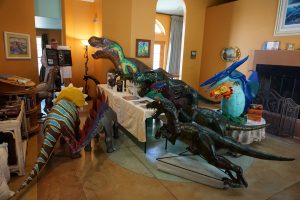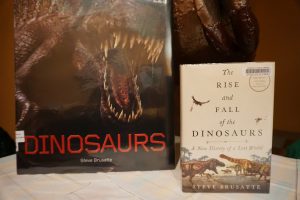The first Dinosaurs evolved around 230 million years ago, during the Middle Triassic period. They began as small carnivores that scurried about on to legs. The dinosaurs expanded into an array of species that spread worldwide. Some were colossal – up 100 feet long and as tall as a five-story building. Others were small and sleek. Meat Eaters with huge teeth many with feathers, downy fuzz, quills and scales. Herbivores with horns, armor, club and whip like tails for protection and/or to attract mates. By the end of the Triassic period, 200 million years ago, Dinosaurs dominated the globe. Their Empire lasted 160 million years.
People have been discovering and studying dinosaurs for 200 years. The first discoveries were in England in the early 1800’s. In the 20th & 21st century technology to study what these amazing animals left behind has changed our understanding of how these animals lived. New and better-preserved fossils have dramatically changed what we thought they looked like. Many had Feathers or fuzz like down. Even the colors of some Dinosaur are now known from examining the melanosomes remaining in some of the fossils. The mission hasn’t changed from those 19th century scientists who first encountered them – to find fossils, piece together the rock & petrified bone to determine how these animals moved what they ate and how they lived.
Finding fossils is very time consuming. Paleontologists use information geologists have gathered looking for minerals to search for rock formations from the time of the dinosaurs. Paleontologists travel to these areas and search using their eyes looking for eroded bone fragments that might indicate a buried more complete specimen. You can imagine how often they may not find anything. Also, areas that have been well scavenged may end up yielding great discoveries after a major flood or excavation has exposed previously hidden rock & fossilized bones.
Once a fossil is discovered, painstaking efforts are made to remove it carefully from the site. This requires careful estimating the amount of rock to remove to make sure the entire fossil is contained. Wrapping and plastering the rock to protect it in transport to museum lab. Then the slow process to remove the fossil carefully from the rock begins at the lab. After cleaning and study which can take years, a paper is written for the scientific community. Not all discoveries are of interest to anyone but other scientist. But every now and then a discovery is so fantastic or important that it’s celebrated with the world. Exhibits at Museums are the most common way to do this.
Scientists have classified Dinosaurs in 3 major groups – the carnivorous Theropods (includes Tyrannosaurus and family), the long-necked herbivores Sauropods (Brontosaurus, Brachiosaurus, Diplodocus) and the beaked plant eating Ornithischians (Stegosaurus, Triceratops and Hadrosaurs). Dinosaurs lived during the Mesozoic Era 251 – 65.5 million years ago. The Mesozoic Era is broken down to 3 time periods: Triassic 251 – 199.6 million years ago, Jurassic 199.6 – 145.5 million years ago and the Cretaceous 145.5 – 65.5 million years ago.
“Dinosaurs” by Steve Brusatte has been a great reference for this article. The book was published in 2 sizes 17.5 inches X 14 inches and 14.5 inches X 12 inches. The large size is fantastic for presentations to groups with many pictures crossing both pages 28 inches wide when opened. The smaller size has the same content. Its more compact size makes for easier individual reading. Even though it was published in 2008 a great deal of the information is still relevant. Check out Steve Brusatte’s recent book “The Rise and Fall of the Dinosaurs: A New History of a Lost World”.
“Encouraging the Appreciation of Art and Education through the Inspiration of Dinosaurs”
Join Max the T-Rex & I at the City of Camarillo Library for a Reading
of Dinosaur Fun Facts & Tales followed
by a “How to Draw Dinosaurs” Activity on March 12th at 7:00 PM
4101 Las Posas Road, Camarillo
Paul & Prehistoric Pals
Your feedback is appreciated, Thank you!








